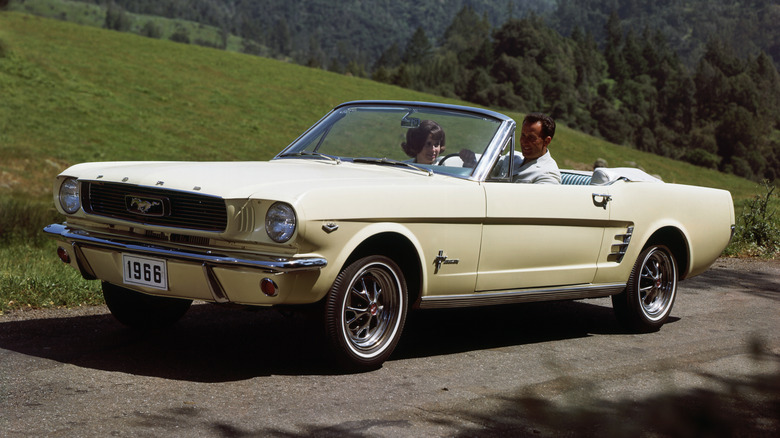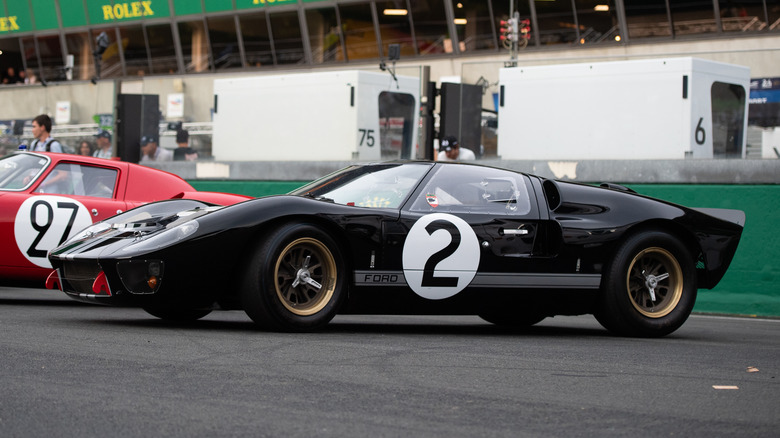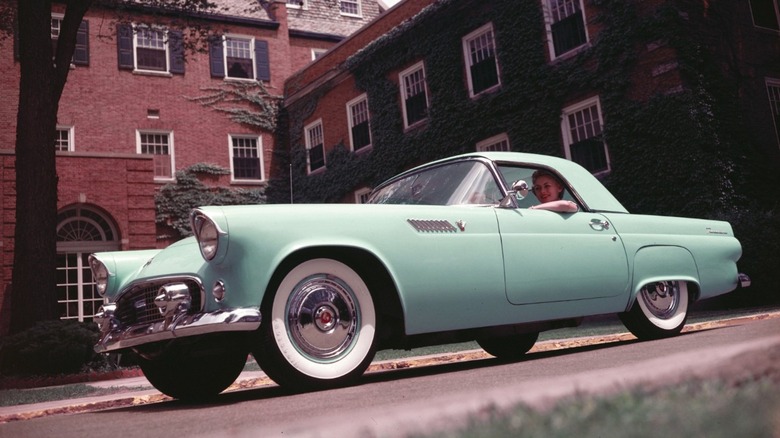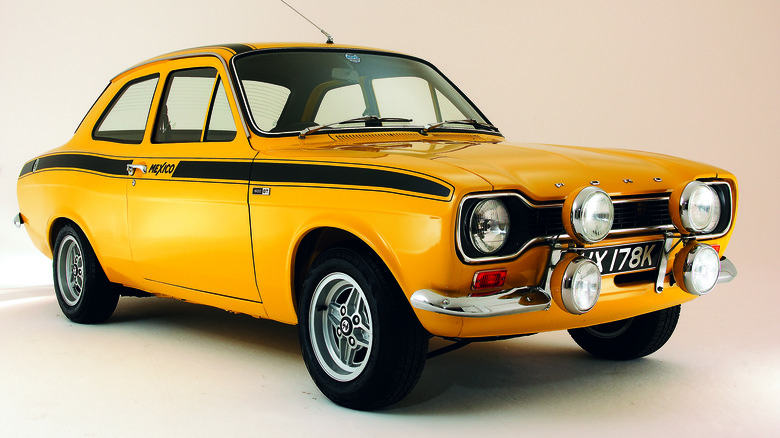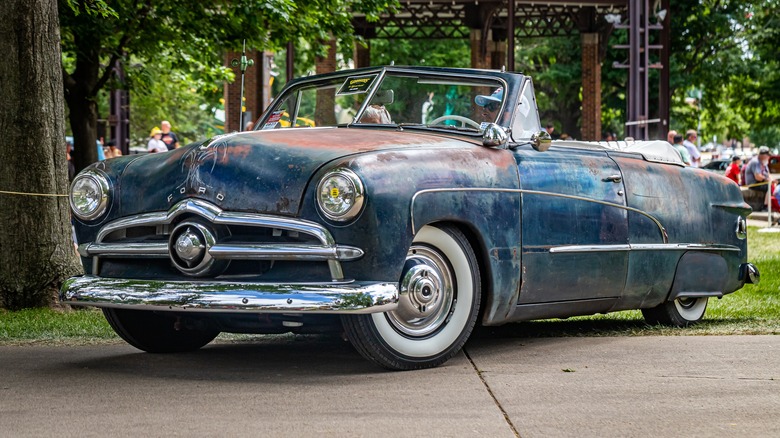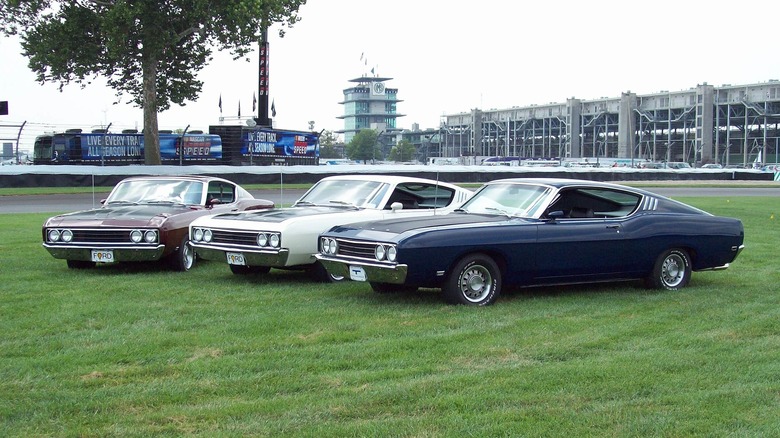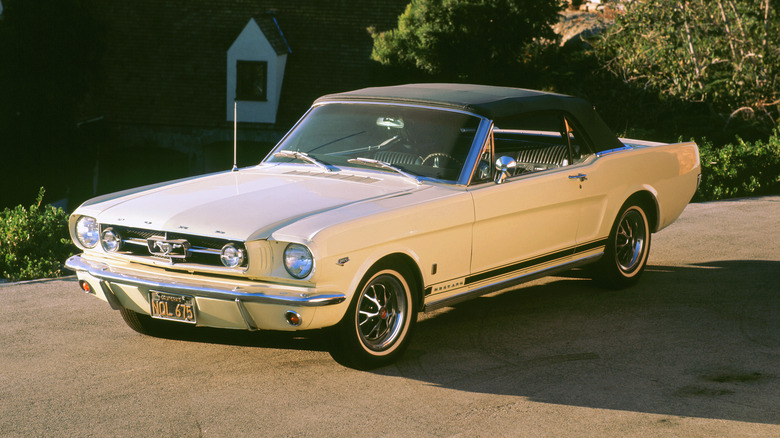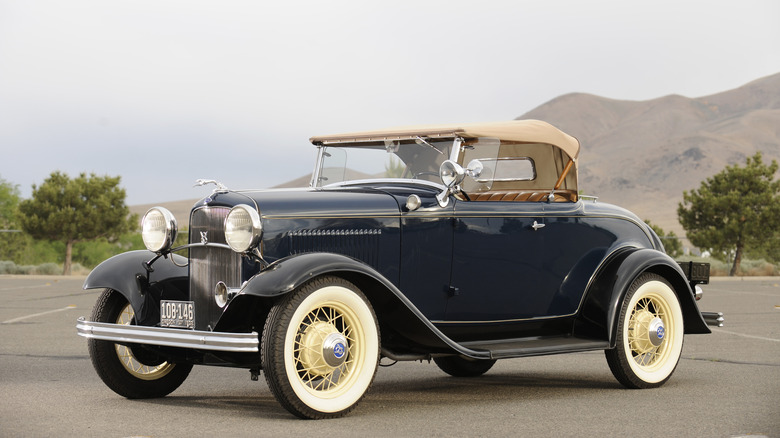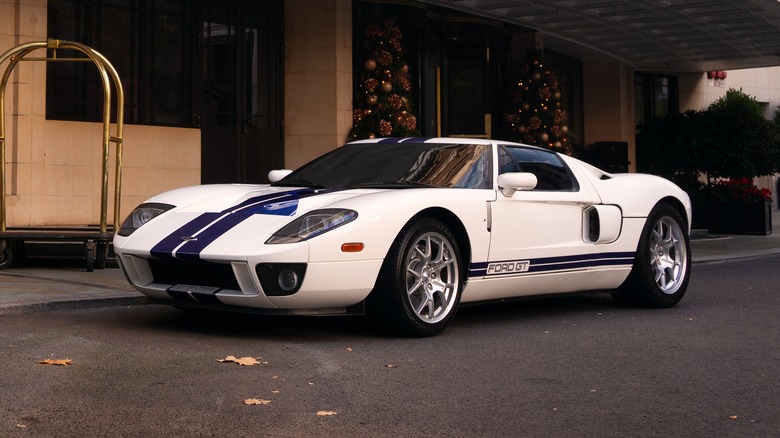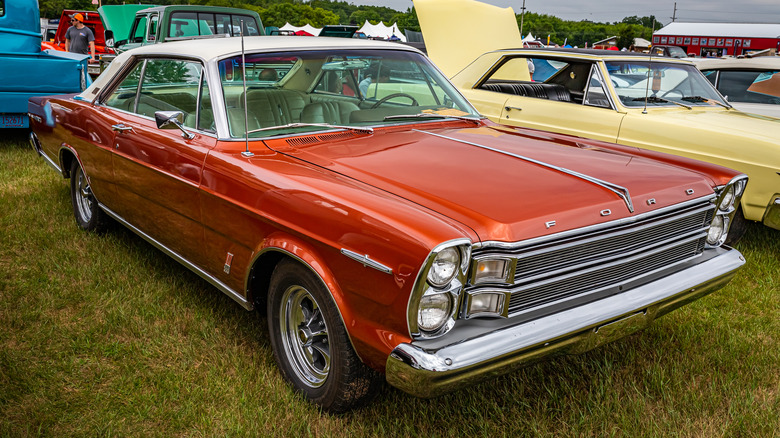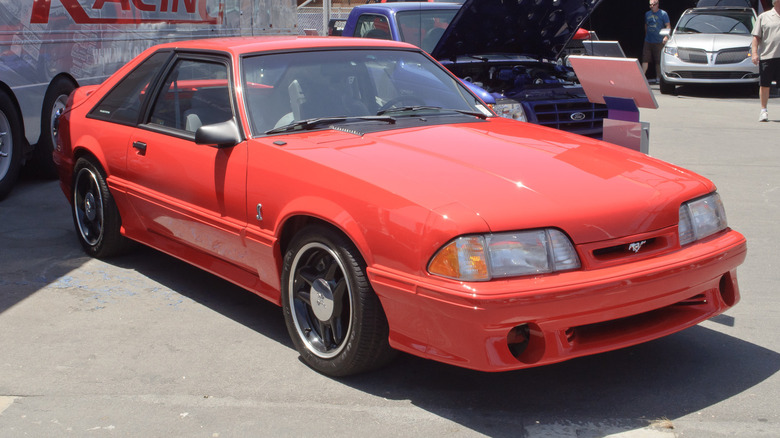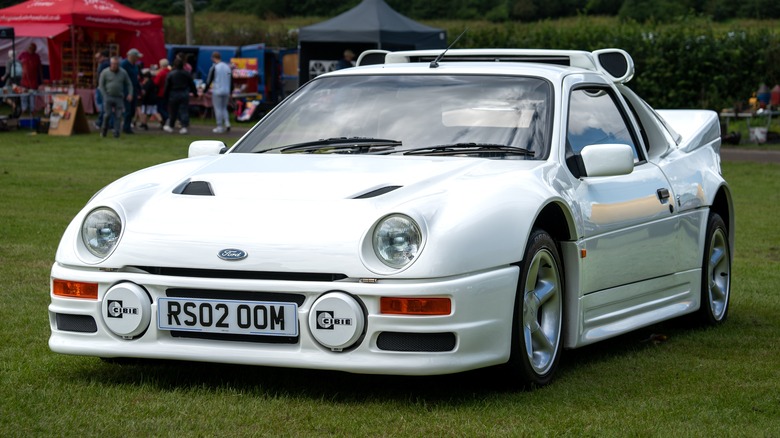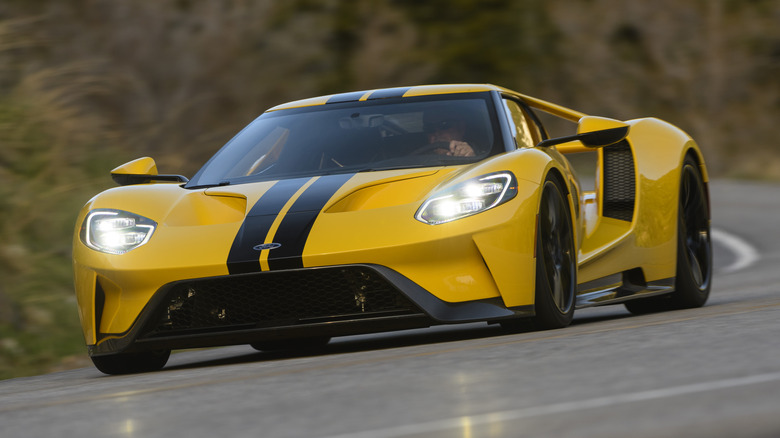12 Of The Best Looking Ford Car Models Ever Designed
Whether it's the chrome-laden boulevard cruisers of the '60s or the lightweight supercars that have formed Ford's halo offerings in recent decades, Ford has certainly produced plenty of design triumphs over the decades. Among them are cars both everyday and the exotic, with some designed to compete against existing rivals both domestic and foreign, and some launching entirely new segments.
Narrowing down the company's decades of design successes down highlights inevitably means that a number of enthusiast favorites didn't make the cut. This roundup isn't intended to be an exhaustive selection of all of the company's best designs ever, but rather aims to cover as broad a range of its history as possible, from bestselling family favorites to limited run motorsports specials and overlooked gems from decades past. To keep things simple, SlashGear hasn't included cars from either Shelby or Lincoln here — both have so many design highlights that they deserve lists of their own. Ford's trucks were also excluded for the same reason.
Ford GT40
Ford's path to claiming victory at the greatest endurance race in the world was far from a straightforward one, and throughout much of the GT40's development, it seemed unlikely that the car could triumph against a then-dominant Ferrari. However, thanks to the unique design features of the GT40 and the sheer determination of the engineers behind it, the car would eventually take the checkered flag for the first time in 1966.
The initial prototype GT40 looked very different to the car that would go on to win in '66, being based on a Lola racing chassis and initially taking design inspiration from the English race car. After the prototype proved uncompetitive, the design was overhauled, with Ford's small team adapting the shape of the car ad-hoc in response to results from test sessions and race days. Even after the '66 win, further adjustments were made in the following racing seasons to keep the car at the front of the pack, and many surviving race-spec GT40s look subtly different when lined up side by side.
However, it's the '66 Le Mans winning example that remains the definitive version of the car for most people, with its low-slung, aerodynamically-optimized lines having become a symbol of Ford's new era of racing success. The car is such an icon that, when Ford decided to relaunch the GT nameplate in the early '00s, it was decided that the new car should look as similar to the '60s classic as possible.
Ford Thunderbird '55
Later generations of the Thunderbird expanded in both size and weight, but the original T-Bird was a straightforward, sporty cruiser designed to bring driver enjoyment to the masses. It nearly wasn't called the Thunderbird — previous suggestions for names had included Runabout and Beaver — but a last minute suggestion from designer Alden Giberson ensured that it launched with its now famous name. It was first unveiled for the 1955 model year and sold well at launch, although it only took a few years for the T-Bird to start gaining serious heft in response to changing market tastes.
As a result, the original generation holds a particular appeal to many collectors, with its simple, elegant design and relatively compact proportions making it stand out from its contemporaries. The closest rival at the time was the Chevrolet Corvette, but it was the Thunderbird that proved more popular in its early years. After its initial expansion in following generations, the Thunderbird never regained its slim figure, although it remained a part of the Blue Oval's lineup for decades after its heyday. The most recent generation was retired in the mid-'00s due to slow sales.
Ford Escort Mk1 Mexico
Alongside its primary American operations, Ford also has a number of international operations around the world. Its most notable is Ford of Europe, which has operated semi-independently for many decades and produced a number of local legends during that time. One of the most revered among enthusiasts is the original Ford Escort Mexico. Race-spec versions of the Escort had seen great success in rallying, and the Escort Mexico allowed buyers to get a slice of that racing expertise at an attainable price.
Most surviving examples today lean further into that rallying heritage, often with stripped-out interiors, performance upgrades, and period-correct rally trim. The Escort's design is a simple one, but one that has arguably aged very well over the decades. Whether it's left stock or decked out in competition-spec rallying gear, there are few cars that encapsulate the classic rally look better than the original Escort Mexico.
Ford Custom '49
In the years following the Second World War, Ford had struggled to rebuild itself into a mass-market carmaker. It was relying on old prewar designs while its rivals had begun to launch new, updated models. That all changed with the launch of the 1949 Ford, which replaced the old bulky Ford designs with a smaller, neater, and more flowing body shell that could be bought in a variety of configurations. Across the range, everything from a two-door convertible to a station wagon was offered, with each variant sporting the same front fascia and taillights.
Over 1 million examples were produced during 1949, with the car's success giving Ford a vital injection of funds as well as helping to turn its image around. Its important place in the company's history has made it a collectible today, but it may never have seen such success had Ford not taken a risk with such a drastic design overhaul compared to its outgoing range.
Ford Torino Talladega '69
While it's not as well-remembered as other high-powered muscle cars from its era, the Ford Torino Talladega arguably looks just as good as any of them. The Torino Talladega was a limited run special produced only during 1969, with just 750 examples built in total. It was designed to meet homologation requirements for NASCAR — hence the low production run — and the racing version of the car was successful on track, racking up 29 victories over two seasons. The road going version boasted many of the same upgrades as the race car, with a new front end and a lower stance to reduce drag.
It was a cleaner design than the standard car, with revised headlight placement to optimize airflow and a custom bumper. Each car also gained a matte black hood as standard. It was a rare car at the time and has become even more of a rarity today, but thanks to its racing success and unique looks, examples of the car draw plenty of attention when they appear for sale.
[Featured image by Carl Sharp via Wikimedia Commons | Cropped and scaled | CC BY-SA 3.0]
Ford Mustang '64.5-'66
The original Mustang shaped not only Ford's history but that of American automotive manufacturing itself, and today the nameplate remains an integral part of the brand's range. Alongside its performance, a key part of the car's appeal was its design, which took inspiration from a variety of sources. Ford conducted extensive in-house research on what the car should look like, presenting focus groups with various ideas until they landed on a European-inspired look that was small, nimble, and appealing to both men and women. Ford's designers reportedly borrowed design elements from Ferraris and Maseratis of the era, giving the car a more exotic appearance but without an exotic price tag to match.
The car proved to be a smash hit straight from its launch, leaving rivals like Chevrolet scrambling to catch up. Later generations of the car would depart from the original vision, adding an angrier, more performance-oriented look to correspond with the car's increasing power output. However, none of these later iterations arguably look quite so timeless as the first generation car.
Ford V8 '32
Worried by the significant advancements of his rivals in the early 1930s, Henry Ford instructed his team to develop a brand new car that would be offered with a V8 engine. At the time, this was unheard of for a mass-market car — only luxury carmakers could offer as many cylinders, with Chevy settling for six and Ford's older cars relying on four-cylinder engines. The resulting 1932 Ford Model 18 changed the car market at its launch, positioning Ford as America's premier automaker once again thanks to its unprecedented popularity.
Ford's V8 engine was a unique creation, being built at a much lower production cost than its rivals thanks to its cast iron design. However, the car would never have been as popular were it not for the new styling debuted alongside this new, more powerful engine. Ford's 1932 car was offered in a large range of styles, with the coupe and the roadster being the two most sought after among collectors today.
In the decades after the car was produced, it also gained a second life as one of the most popular models of the fledgling hot rod scene. Most surviving examples of the '32 Ford V8 today have been hot-rodded to some degree, with the car now more famous in its stripped-down, modified form than it is with its original styling.
Ford GT '05
Much like the original Ford GT40, the Ford GT of the early '00s was designed to beat a Ferrari. This time, it was the Ferrari 360 Modena road car rather than a race car, and it's safe to say that Ford more than met its goals. The GT was significantly faster and significantly more powerful than the 360 Modena, and in the eyes of many, it looked better, too. Of course, it was not a clean sheet design: The GT was intended to resemble the original GT40 as closely as possible, albeit with the benefit of modern chassis and drivetrain technology.
That meant that the revived GT was significantly larger than the original GT40, although it's difficult to tell unless the two are lined up side by side. The GT was launched in 2004 as a 2005 model year and remained in production only until 2006, but it made an impact even with such a short production run. Ford's reputation as a bona fide supercar maker had been restored, and in the process the company had produced what remains one of its best looking cars of the century.
Ford Galaxie '66
Several model years of the Ford Galaxie could have been included here, but the '66 made the cut thanks to its clean lines, distinctive headlights and taillights, and European styling influences. The top-spec variant in the range was the '66 Galaxie 500 7-Litre, which combined the car's elegant yet relatively unassuming looks with a tire-shredding V8 engine. The Galaxie was redesigned for the 1965 model year with a smoother ride and lighter weight. For 1966, its styling was further tweaked, with a number of minor improvements including the introduction of "Coke-bottle" tapering at the rear of the car.
These subtle changes proved a hit with buyers, and helped Ford achieve the number one spot for sales among American automakers that year. The same Galaxie generation would continue to be produced through 1968, with further tweaks debuted with each new model year. However, later models never captured as many buyers, with the Galaxie name being phased out as the next decade rolled around.
Ford Mustang SVT Cobra R '93
The Foxbody Mustang remains a popular collectors' car with enthusiasts, with one of the most desirable variants being the 1993 SVT Cobra R. Mechanically, it was an upgrade over the Mustang GT, with 30 more horsepower on offer alongside a bevy of performance parts, but only minor styling tweaks were made. Aside from the Cobra logos, there was a new grille, a few changes to the vent designs, and tweaked taillights.
However, it's this subtlety that has given the SVT Cobra a timeless appeal that many of its contemporaries lack. It still looks sharp today in any of its trio of available colors, especially if it's been looked after properly. Many examples haven't, having been driven hard for many years and subject to cut corners in maintenance, but a clean example still turns plenty of heads. As a result, prices for the very best examples can hit six figures.
[Featured image by InSapphoWeTrust via Wikimedia Commons | Cropped and scaled | CC BY-SA 2.0]
Ford RS200
Despite the Ford RS200 never getting to prove its worth in competition, it remains one of the brand's best known cars, as well as one of its most distinctive looking. It was originally designed to compete in Group B rallying, being built from the ground up to dominate stages against fierce competition. However, the reality was a little different than Ford's bosses had originally envisioned. The car's appearance in the 1986 World Rally Championship season was marred by reliability issues, although it did reach the podium in Acropolis Rally Greece.
A number of high-profile fatal crashes throughout the season saw the Group B category axed on safety concerns, leaving the RS200 redundant mere months after its debut. Ford sold the remaining examples of the car off to private customers at significant discounts, while unsold examples sat in storage for years until they could finally find buyers. Decades later, they've become sought after collectors' cars, both for their hairy-chested performance and their unique designs.
Ford GT '17
The second generation of the Ford GT was unveiled in 2017, with SlashGear grabbing the keys to one in the spring of that year. The primary takeaway was that the car's performance was a step above anything previously offered by the Blue Oval, but second to that was just how good the car looked in the metal. While the mid-'00s incarnation of the GT stuck as closely to the original GT40 design as possible, the latest GT took a different approach.
Although there are some key similarities to the classic, the 2017 GT is very much its own design, and it's all the better for it. It was sculpted for optimal aerodynamics, but it balances form and function better than most track-oriented supercars. Unlike the previous GT and GT40, the latest car isn't built to rival a Ferrari, at least not directly, but it still boasts the looks to match up against Maranello's finest. Production ended in 2023 and Ford is now focused on the development of the halo Mustang GTD. No announcements have been made to date as to whether another generation of the GT will eventually be unveiled, but if it is, here's hoping it looks as good as the latest car.
